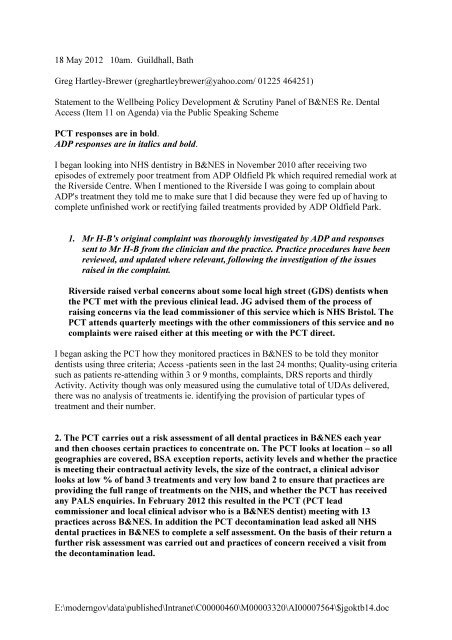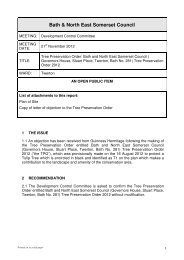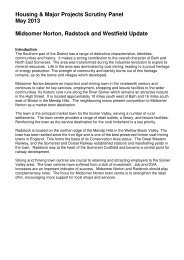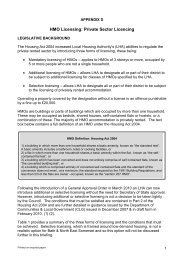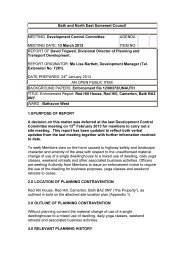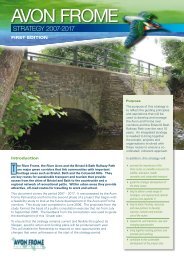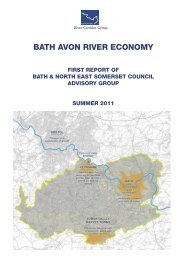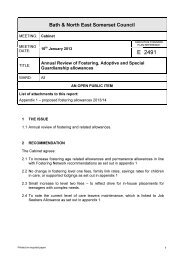Comments to letter from GHB , item 33. PDF 86 KB
Comments to letter from GHB , item 33. PDF 86 KB
Comments to letter from GHB , item 33. PDF 86 KB
You also want an ePaper? Increase the reach of your titles
YUMPU automatically turns print PDFs into web optimized ePapers that Google loves.
18 May 2012 10am. Guildhall, BathGreg Hartley-Brewer (greghartleybrewer@yahoo.com/ 01225 464251)Statement <strong>to</strong> the Wellbeing Policy Development & Scrutiny Panel of B&NES Re. DentalAccess (Item 11 on Agenda) via the Public Speaking SchemePCT responses are in bold.ADP responses are in italics and bold.I began looking in<strong>to</strong> NHS dentistry in B&NES in November 2010 after receiving twoepisodes of extremely poor treatment <strong>from</strong> ADP Oldfield Pk which required remedial work atthe Riverside Centre. When I mentioned <strong>to</strong> the Riverside I was going <strong>to</strong> complain aboutADP's treatment they <strong>to</strong>ld me <strong>to</strong> make sure that I did because they were fed up of having <strong>to</strong>complete unfinished work or rectifying failed treatments provided by ADP Oldfield Park.1. Mr H-B’s original complaint was thoroughly investigated by ADP and responsessent <strong>to</strong> Mr H-B <strong>from</strong> the clinician and the practice. Practice procedures have beenreviewed, and updated where relevant, following the investigation of the issuesraised in the complaint.Riverside raised verbal concerns about some local high street (GDS) dentists whenthe PCT met with the previous clinical lead. JG advised them of the process ofraising concerns via the lead commissioner of this service which is NHS Bris<strong>to</strong>l. ThePCT attends quarterly meetings with the other commissioners of this service and nocomplaints were raised either at this meeting or with the PCT direct.I began asking the PCT how they moni<strong>to</strong>red practices in B&NES <strong>to</strong> be <strong>to</strong>ld they moni<strong>to</strong>rdentists using three criteria; Access -patients seen in the last 24 months; Quality-using criteriasuch as patients re-attending within 3 or 9 months, complaints, DRS reports and thirdlyActivity. Activity though was only measured using the cumulative <strong>to</strong>tal of UDAs delivered,there was no analysis of treatments ie. identifying the provision of particular types oftreatment and their number.2. The PCT carries out a risk assessment of all dental practices in B&NES each yearand then chooses certain practices <strong>to</strong> concentrate on. The PCT looks at location – so allgeographies are covered, BSA exception reports, activity levels and whether the practiceis meeting their contractual activity levels, the size of the contract, a clinical advisorlooks at low % of band 3 treatments and very low band 2 <strong>to</strong> ensure that practices areproviding the full range of treatments on the NHS, and whether the PCT has receivedany PALS enquiries. In February 2012 this resulted in the PCT (PCT leadcommissioner and local clinical advisor who is a B&NES dentist) meeting with 13practices across B&NES. In addition the PCT decontamination lead asked all NHSdental practices in B&NES <strong>to</strong> complete a self assessment. On the basis of their return afurther risk assessment was carried out and practices of concern received a visit <strong>from</strong>the decontamination lead.E:\moderngov\data\published\Intranet\C00000460\M00003320\AI00007564\$jgoktb14.doc
3. The practice visit included looking at their vital signs report for last year (2010/11)and year <strong>to</strong> date this year(2011/12). The PCT also discussed the End of year (2010/11)statement with each practice that includes the clinical dataset. The PCT also discussedany PALS issues notified <strong>to</strong> the PCT and any complaints that the practice had received<strong>from</strong> patients in the previous year. As a result of this visit the PCT drew up an actionplan which all the practices signed up <strong>to</strong> achieving. This process was reported <strong>to</strong> thePCT PEC and Board within the integrated performance report.4. The risk assessment process was carried out because the PCT was unable <strong>to</strong> visit alldental practices due <strong>to</strong> capacity issues. This was logged formally on the PCT riskregister.As you all know the new dental contracts act as a disincentive <strong>to</strong> dentists <strong>to</strong> undertake themore complicated work, such as root canals, because they are paid a fixed rate which takeslittle account of how complicated the treatment is in terms of the labour or material costs.This is why it is essential that the PCT and the new CCGs moni<strong>to</strong>r the type and quantity oftreatments <strong>to</strong> ensure that dentists don't 'cherry pick' or 'game' the system. The PCT has notbeen doing this.5. As stated above the PCT does moni<strong>to</strong>r the type of treatment provided such as rootcanals. It will not be the role of CCG <strong>to</strong> commission dental services in the future as thiswill be part of the National Commissioning Board’s responsibility.I asked the PCT through an FOI request <strong>to</strong> provide me with a copy of the most recent DentalReference Officer's inspection report for ADP Oldfield Park which was undertaken in June2010 <strong>to</strong> be <strong>to</strong>ld, on 22 Feb 2011, that they had not received the report. I also asked the PCTwhether they moni<strong>to</strong>red treatments by type and number <strong>to</strong> be <strong>to</strong>ld and I quote;“ Some PCTs may moni<strong>to</strong>r this level of detail with their practices but we do not in B&NES.”6. Please see above. The PCT at this time did not routinely check every dental practiceclinical dataset but used the risk assessment process described above.After some basic checking by phoning the Dental Services Division the PCT then agreed thatin fact they would have received the Dental Reference Officer's report online <strong>from</strong> the DentalServices Division two or three days after the Dental Reference Officer's visit but the reporthad not been studied because Val Janson and one other had visited the practice in person andfound no issues of concern.7. The DRO has s<strong>to</strong>pped visiting dental practices in England as part of this work iscarried out by CQC now. Normally the PCT receives the DRO reports <strong>from</strong> colleaguesin NHS Bris<strong>to</strong>l PCT who lead on commissioning dental services across old Avon. Butthere was long term sickness and maternity leave in this team so in this instance thePCT did not receive the report in a timely way. Normally when the PCT had receivedthe DRO report the PCT sent a request 6 months later <strong>to</strong> ask the practice if they hadcarried out the actions as agreed by the DRO. This did not happen in this instance. As aresult of a higher than average number of PALS/complaints received at the PCT theclinical governance lead clinician and the quality lead manager attended a contractmeeting <strong>to</strong> discuss complaints and general quality management systems and processeswith ADP. They also visited the practice in February 2011 <strong>to</strong> discuss a particularE:\moderngov\data\published\Intranet\C00000460\M00003320\AI00007564\$jgoktb14.doc
complaint and at that time received assurance <strong>from</strong> the ADP Clinical Direc<strong>to</strong>r thatclinical competency and clinical record keeping were assessed on a regular basis and itwas felt that the practice could improve its complaints record management andimplement a more effective system for learning <strong>from</strong> complaints. On the basis of theissues discussed and the actions agreed the PCT was satisfied that progress would bemade.Furthermore the PCT then denied they received the General Clinical Data Set <strong>from</strong> the DentalServices Division, either the quarterly ‘vital signs’ reports or the annual reports for everyNHS dentist in B&NES. The criteria the PCT said they DID use <strong>to</strong> moni<strong>to</strong>rAs an attachment<strong>to</strong> this document I have included the General Clinical Data Set for ADP Oldfield Park for2010/11 with causes for concern regarding activity highlightedaccess, activity and quality can only be found in this data! What were they trying <strong>to</strong> hide?Was it the complete lack of moni<strong>to</strong>ring taking place and/or trying <strong>to</strong> obscure what the datawould show?8. The PCT was not trying <strong>to</strong> hide any information. The PCT does not receive thesereports direct but can download them <strong>from</strong> a website. At the time of Mr HB requestthere was no-one in the PCT who could access this website. (As a key member of staffhad just left). As stated previously stated the PCT does review these reports as part ofthe risk assessment process.I have submitted <strong>to</strong> Lauren Rushen the full General Clinical Data sets for each NHS practicein B&NES for 2009/10 and 2010/11 and the Dental Contract Management Handbook 2010which gives advice on how <strong>to</strong> interpret this data. It gives guidelines for figures that shouldraise concerns. I believe the PCT was unaware of this document or didn't use it if they were.This document also gives specific guidelines in chapter 9 regarding “Questions for theOverview and Scrutiny Committee.”For example-“Does the PCT protect patients by ensuring the quality of dental services?”“Does the PCT have audited processes for moni<strong>to</strong>ring efficiency and effectiveness of dentalcontracts?”9. The PCT is aware of the Dental Contract Handbook 2010 which gives very helpfuladvice for dental commissioning. This was reviewed <strong>to</strong> form the basis of the riskassessment process.Also, the report used by this committee for <strong>to</strong>day's meeting, “Developments in NHSDentistry” Section 7 page 4 states that PCTs have a responsibility <strong>to</strong> improve oral healththrough prevention as well as by access <strong>to</strong> treatment. One of the treatments it lists is theapplication of fluoride varnishes <strong>to</strong> children at high risk of dental decay. The figure for thistreatment for Oldfield Pk for 2010/11 is zero per 100 FP17s; fissure sealants is zero per 100FP17s; scale and polish is 5.6 per 100 FP17s Band 1 when the national average is 39.5 per100 FP17s. They treated a <strong>to</strong>tal of 13,518 patients and specifically 3,032 under 18's duringthis period. Prevention, what prevention?E:\moderngov\data\published\Intranet\C00000460\M00003320\AI00007564\$jgoktb14.doc
10. In the contract year 2011-2012 the percentage of child course of treatment receivingFluoride treatment was 9.25%. The current computer systems use the pre-2006 fee scale inorder <strong>to</strong> record what treatment is performed and unless a dentist assiduously uses thesecodes it is not possible <strong>to</strong> accurately measure activity. It has his<strong>to</strong>rically been common <strong>to</strong>simply write a note indicating that these areas have been covered. The use of metrics hasincreased as the 2006 contract has progressed but the interpretation of this kind of datacan be unreliable. ADP can now produce clinical datasets at practitioner level and is nowable <strong>to</strong> discuss the importance of correct recording of this information. The Pilots for thenew dental contract are specifically trialling methods <strong>to</strong> assess the effectiveness ofpreventative measures by looking at treatment outcomes.The PCT has noted that rate of fissure sealants and fluoride varnishes were low for thispractice according <strong>to</strong> the dataset. The clinical direc<strong>to</strong>r of IDH who now own thispractice agreed <strong>to</strong> look in<strong>to</strong> this further at a future contract review meeting with thePCT. This may be a data recording issue.This is a practice that has an unending, permanent contract, awarded without competitivetendering <strong>to</strong> provide just under 60,000 UDAs which was increased <strong>from</strong> 39,000 UDAs 18months/two years ago. This is more than double the next largest provider in B&NES.11. When the PCT inherited commissioning dental services <strong>from</strong> the DH in 2006 alldentists providing General Dental Services (GDS) were given permanent contracts. Thiswas a DH decision <strong>to</strong> stabilise dental services. 18 months/two years ago in order <strong>to</strong>improve access <strong>to</strong> dental services the PCT procured £1.4M worth of services <strong>from</strong> 11practices in B&NES. There were two other practices awarded a similar level of increasein this process. The process used by the PCT included a review of quality standardsand health promotion.The damning report <strong>from</strong> the CQC in<strong>to</strong> Oldfield Park , published two days ago, raises majorconcerns regarding patient safety with regard <strong>to</strong> infection control, Legionella risk and firerisk. The issues raised by the CQC highlight fac<strong>to</strong>rs that were in place at the time of theprevious inspections by the PCT and DRO. For example no sink for staff <strong>to</strong> wash their handsin the equipment decontamination room with staff stating that “we just didn't wash ourhands.”12. The practice has produced an action plan <strong>to</strong> addresses any areas of concern followingthe CQC inspection. Progress <strong>to</strong> implement this action plan is under review by both thePractice and the Company and all areas of concern flagged by the CQC have already beenaddressed. A new decontamination room has been created in the practice and is fullyHTM01-05 compliant. A legionella test was completed in March 2011 but the evidence forthis was not available for inspection at the time of the CQC inspection. PAT testing isarranged for the end of July 2012.CQC have only recently instigated a review of dental services. Prior <strong>to</strong> this starting inthe B&NES area CQC contacted the PCT <strong>to</strong> discuss areas of concern. The PCT advisedCQC of the information that has been reviewed as part of the risk assessment processand the decontamination self assessment. The quality manager advised CQC that thePCT has had cause <strong>to</strong> carry out a quality visit <strong>to</strong> ADP Bath as a result ofcomplaints/PALS enquiries. CQC alerts the PCT when the reports are in the publicE:\moderngov\data\published\Intranet\C00000460\M00003320\AI00007564\$jgoktb14.doc
domain. We know that after a CQC visit the practice has 14 days <strong>to</strong> respond <strong>to</strong> thereport. Dentists with agreement by the Avon LDC will send the PCT a copy of theirreport for information. The PCT will then follow up on any issues of concern.ADP Oldfield Park's reputation precedes it. If I speak <strong>to</strong> people about it very rarely doesanyone have anything good <strong>to</strong> say about it. If the PCT was unaware of this it is because it iswas not asking the right questions. The CQC report, I believe, shows that the practice was notbeing moni<strong>to</strong>red sufficiently. ADP's business model is profits first with patients coming apoor second. The decision <strong>to</strong> give so many UDAs <strong>to</strong> ADP Oldfield Pk was simply aboutgetting a provider operating in B&NES that would always take on NHS patients, this was atthe expense of quality. The PCT, due <strong>to</strong> the his<strong>to</strong>ric problem in Bath of limited NHS dentalcapacity, has concentrated on access at the expense of what happens when a patient isthrough the door. Access, access, access seems <strong>to</strong> have been the mantra for the provision ofNHS dentistry in B&NES. As an attachment <strong>to</strong> this document I have included the GeneralClinical Data Set for ADP Oldfield Park for 2010/11 with causes for concern regardingactivity highlighted13. See previous comments. The PCT is being performance managed by the StrategicHealth Authority on Access <strong>to</strong> NHS Dental Services as this was a priority in the NHSCommissioning Framework in 2011/12.The current vital signs data (March 2012) indicates that 87.8% of patients were happy withthe dentistry they have received. This is more than amplified by the recent PatientSatisfaction Survey (PSS). This clearly shows that the large majority (90% +) of patientsare happy with the service provided. The only PSS question scoring in the blue is the 3.4%who had <strong>to</strong> wait more than 15 minutes. These results are being considered by the practiceand an action plan is produced as a result.The General Clinical Data sets for dentists in B&NES highlight areas as causes for concern ifthe Dental Contract Management Handbook 2010 is used as a guide. The levels of scale &polish across B&NES are low compared <strong>to</strong> national averages. In two cases they are far <strong>to</strong>ohigh, again a cause for concern. I have been asked <strong>to</strong> pay for a hygienist at ADP OldfieldPark when the treatment was deemed clinically necessary. I have had clients at the CitizensAdvice Bureau who have said the same.14. The levels of scale and polish are low across B&NES because a number of practicesin B&NES only see children. Children should not need scale and polish. Scale andpolish should not be needed for patients who have good oral hygiene. NHS hygieneservices are made available <strong>to</strong> patients but only for those patients that clinically requiretreatment <strong>to</strong> maintain their oral health.ADP is currently undertaking a review of the provision of hygienist services <strong>to</strong> ensure thatclear information is available <strong>to</strong> patients around the provision of NHS periodontaltreatment. This will ensure that patients understand the clinical need for periodontaltreatment, what treatments are available <strong>to</strong> patients under the NHS and any privateoptions.The CQC report, page 12, talks about fees and states that,E:\moderngov\data\published\Intranet\C00000460\M00003320\AI00007564\$jgoktb14.doc
“ If an individual requests a scale & polish for cosmetic reasons, it was the practice's cus<strong>to</strong>m<strong>to</strong> refer the patient <strong>to</strong> the dental hygienist. This was then charged for privately.”The scale & polish figures are very low so it may be that dentists are not routinely offeringthis treatment when clinically necessary on the NHS which is why patients are having <strong>to</strong> askfor this treatment. The report states that the PCT has now raised concerns with the providerand I would ask the Committee <strong>to</strong> follow this up and check the specific data for 2011/12 and2012/13 <strong>to</strong> make sure the figures for scale and polish have risen and that the PCT or CCG isregularly using the General Clinical Data Set <strong>to</strong> moni<strong>to</strong>r on a continuous basis.15. The clinical dataset is produced quarterly and a summary of the whole year on anannual basis. We are waiting for 2011/12 outturn data. The PCT meets with 4 dentistsacross B&NES on a quarterly basis for <strong>to</strong> discuss issues with commissioning dentalservices <strong>from</strong> a clinical perspective. We have agreed as part of this years workprogramme that the dentists will go through all the clinical datasets for 2010/11 and2011/12 <strong>to</strong> see if they can see any areas of concern whether this is data quality issues oran unusual clinical practice. The PCT will then write <strong>to</strong> dental practices asking them forfeedback.I then moved practice <strong>to</strong> 1a Queen Sq, twice I was <strong>to</strong>ld I needed <strong>to</strong> see the hygienist andwould have <strong>to</strong> pay £35. I pointed out twice that I was an NHS patient. No offer of treatmen<strong>to</strong>n the NHS was forthcoming. I complained <strong>to</strong> be <strong>to</strong>ld that the dentist concerned had offeredme both options. This was a <strong>to</strong>tal untruth. The General Dental council states that dentistsmust put their patients ahead of any personal or business interest. Why is it that twocompletely different dental models; one a national company and one a family run partnership,felt confident enough <strong>to</strong> breach the General Dental Services contract by asking me <strong>to</strong> payprivately for manda<strong>to</strong>ry preventative treatments that should be available on the NHS?16. A Basic Periodontal Examination (BPE) is the accepted screening <strong>to</strong>ol used <strong>to</strong> assessthe presence of periodontal disease. A BPE of 3 or higher suggests that a diagnosis ofperiodontal disease should be considered, a lower score does not diagnose periodontaldisease and therefore, on the NHS, scaling is not appropriate.The reason, I believe, is because the PCT has given a green light <strong>to</strong> dentists and through theirlack of effective moni<strong>to</strong>ring they've said “Don't worry become an NHS provider so that wecan improve access and once the patient is through the door we wont bother you!”17. see previous comments outlining that the PCT does moni<strong>to</strong>r quality.I had a meeting with the practice manager at 1a Queen Square <strong>to</strong> raise my concerns. She wasvery honest. She stated that she thought their figures for scale and polish would be lowbecause many of their NHS patients paid privately for the hygienist. She had never seen theGeneral Clinical Data Set figures for any of the practice's dentists. Finally she <strong>to</strong>ld me shehad had no contact with the PCT for several years. There is no guidance being given <strong>to</strong> NHSproviders in B&NES. Does the PCT have any knowledge of what's happening at theNHS/private interface?18. The practices in B&NES received the general clinical dataset figures directly <strong>from</strong>the BSA in June 11 as shown by the report that Mr HB sent you. The PCT can assurethe committee that the PCT has been in regular contact with Queen Square. Thedentists in this practice have separate contracts with the PCT and they correspondE:\moderngov\data\published\Intranet\C00000460\M00003320\AI00007564\$jgoktb14.doc
directly with the PCT on a regular basis. This practice manager has contacted the PCTon a number of occasions.I have spoken <strong>to</strong> Karen Taylor of the CQC who stated that there is an issue with regard <strong>to</strong> theaccuracy of the data because there is a lack of uniformity on recording pro<strong>to</strong>col. But theDental Services Division does have explicit instructions on it’s website on how <strong>to</strong> record datausing the FP17s and dentists do after all get paid <strong>from</strong> this data so it’s inaccuracy cannot besignificant. If the PCT believes the data <strong>to</strong> be less than accurate then it should ensurereporting is consistent via oversight.19. The PCT piloted the use of clinical datasets with dentists as part of the practice visitprocess. See previous comment about work programme this year for the 4 B&NESdentists.Has any dentist in B&NES in the last three years had a remedial or breach notice issuedagainst it? What are the bench mark figures the PCT uses when action will be instigated?NHS dentistry in the UK is in state of flux. Dentists find it hard <strong>to</strong> provide all the treatmentsavailable on the NHS and make a living because of their contracts. So the patient pays theprice through a blurring of the NHS/private relationship.20. Some dentists in B&NES have been issued with remedial notices that relate <strong>to</strong> notachieving activity targets. But these issues have been resolved as part of the year endreconciliation process. There are no outstanding remedial notices.The difference in quality between NHS and private treatment is significant. This disparity isnot something we would put up with <strong>from</strong> our local GP and yet we have <strong>to</strong> accept a two tierhealth service when it comes <strong>to</strong> oral health.21. The PCT does not have access <strong>to</strong> the quality of private dental treatment so is notable <strong>to</strong> comment.This point onwards the report is making recommendations <strong>to</strong> the Wellbeing PDS.I don't expect the Committee <strong>to</strong> make recommendations based solely on what I have said<strong>to</strong>day and I would be happy <strong>to</strong> be proved wrong. But I would ask that you recommend aninvestigation in<strong>to</strong> the NHS/private relationship in B&NES and set up a system <strong>to</strong> moni<strong>to</strong>r thetype and number of treatments using the General Clinical Data Set.I have spoken <strong>to</strong> Karen Taylor of the CQC who stated that there is an issue with regard <strong>to</strong> theaccuracy of the data because there is a lack of uniformity on recording pro<strong>to</strong>col. But theDental Services Division does have explicit instructions on it’s website on how <strong>to</strong> record datausing the FP17s and dentists do after all get paid <strong>from</strong> this data so it’s inaccuracy cannot besignificant.This could be investigated by:1. Sending a <strong>letter</strong> reminding dentists of their statu<strong>to</strong>ry duties <strong>to</strong> provide manda<strong>to</strong>ry servicesunder the General Dental Services contract and not <strong>to</strong> direct patients <strong>to</strong> private care wherethat treatment is clinically necessary.E:\moderngov\data\published\Intranet\C00000460\M00003320\AI00007564\$jgoktb14.doc
2. Compel dentists <strong>to</strong> place the document “Guide <strong>to</strong> NHS Dental Services in England”,http://www.dh.gov.uk/en/Publicationsandstatistics/Publications/PublicationsPolicyAndGuidance/DH_097431 (see pages 11 & 13) which is about NHS dental rights, in their waitingrooms with signs informing patients they should read it.3. Lastly 6 months after that has been done undertake a patient questionnaire survey listingthe treatments available on the NHS and ask the basic question “Have you ever been asked <strong>to</strong>go private for any of these treatments available on the NHS or <strong>to</strong>ld that the treatment wouldbe better if done privately?”4. Moni<strong>to</strong>r the number and types of treatment being offered so that the PCT/CCG knows that‘gaming’ or 'cherry picking' is not occurring.At the present time if you need root canal work that’s moderately complicated on the NHSyou loose your <strong>to</strong>oth because it's not economically viable for a dentist <strong>to</strong> spend two hourstreating a patient. Look at the General clinical data set and see how low the figures are forthis treatment. Why not do what Wiltshire have done and provide a dentist with anendodontic specialism one afternoon per week?One of this Committee's remits is reducing health inequalities. In B&NES if you can affordprivate treatment you save your <strong>to</strong>oth, if you are an NHS patient you lose it. To me that is aglaring example of a health inequality.I would also recommend watching Channel 4's Dispatches programme ‘The Truth AboutYour Dentist’ broadcast on the 18 May 2011 and still available on Channel 4 OD.Finally, I would agree with <strong>to</strong>day’s proposition that access has improved, but now let’s alsoconcentrate on what happens when a patient gets through the door.NB. As a separate attachment <strong>to</strong> this document I have included the General Clinical Data Setsfor 2010/11 for B&NES. Please look at the first two practices on the list (page 5 of both)which are ADP Oldfield Park and ADP Walwyn Close, Twer<strong>to</strong>n for 2010/11. In particularsee 'scale & polish' and 'fluoride varnish'. Remember the PCT only moni<strong>to</strong>rs 'activity' by thecumulative <strong>to</strong>tal for UDAs not the breakdown of that activity ie. the number of 'scale &polishes' or the number of 'fluoride varnishes'. This is what needs <strong>to</strong> be moni<strong>to</strong>red.Below is the criteria the PCT will state they use <strong>to</strong> moni<strong>to</strong>r for 'quality', 'access' and 'activity'.Ask the PCT <strong>to</strong> provide evidence of this moni<strong>to</strong>ring not just a list of what it states it uses!AccessPatients seen in 24 monthsActivityCumulative percentage of contracted UDA deliveredQuality% of FP17s for the same patient ID Re-attending within 3 months% of FP17s for the same patient ID Re-attending between 3 and 9 monthsE:\moderngov\data\published\Intranet\C00000460\M00003320\AI00007564\$jgoktb14.doc
% of FP17s for Band 1 Urgent Courses% of FP17s Relating <strong>to</strong> Free Repair or Replacements% of FP17s Relating <strong>to</strong> Continuations% of Patients satisfied with the dentistry they have received% of Patients satisfied with the time they had <strong>to</strong> wait for an appointmentPALS and complaints & DRS reportsE:\moderngov\data\published\Intranet\C00000460\M00003320\AI00007564\$jgoktb14.doc


